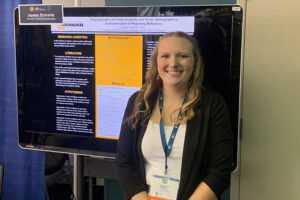Darian Dixon takes pictures of Mars for a living, and it’s more than a point-and-click operation. The 2015 UWM graduate is a mission operations specialist at Malin Space Science Systems, a California company that operates some of the cameras for NASA’s Mars Curiosity rover. Dixon, who has a bachelor’s degree in geosciences, teams up with colleagues to construct and send the complicated computer commands for taking the photos. Then they must wait a day or two before images are transmitted back to Earth and processed. “It is still the basics of traditional photography,” Dixon says, “just done on another planet in a really remote way.”
What more can you share about being a mission operations specialist?
I would say it’s a fancy way to say “space camera operator.” That’s what I like to call it. Essentially, there are two color cameras called the Mastcams, because they’re sitting on top of the mast. And so in my job, I operate those cameras, I ensure the health and safety of those cameras, I help manage the data and help deliver the data that will be taken to the public and to the scientists.
What’s a typical day like?
It’s coming in, getting the lay of the land and just diving in with the rest of the team and figuring out what we write in those commands. During that whole process, there’s just a ton of constant checking, constant reading over what we write, constantly making sure our numbers make sense. It’s extremely collaborative, which is welcome.
How did UWM prepare you for your career?
The geosciences department was great – awesome faculty. They were really willing to give students opportunities to explore their own interests. I worked with a professor who was also the undergraduate advisor for the department at the time, Lindsay McHenry. She also studies Mars and a lot of environments here on Earth. She studies Mars minerology. I shared my interests with her. She was able to use grant money for me to be on her research team at Lassen Volcanic National Park in California helping out one of her grad students. That was kind of my first big research project, and that was probably the most influential thing that got me on this path.
What are your best memories at UWM?
One is definitely that research trip to Lassen Volcanic National Park. That was my first time ever going to a national park. I was also a mentor at the Student Success Center to new students. Outside of academics and science, working there was my favorite experience. We did a lot of events, a lot of stuff with new students in the summer. Twenty to 30 undergrads in a small office getting people excited about school.
What’s the coolest or weirdest image that you’ve taken on Mars?
I would say the sand, honestly. The chemistry of the rocks on Mars, it’s what’s called mafic, and mafic rocks are typically more iron- and magnesium-rich rocks. They’re dark in color. Essentially, sand comes from rocks and it’s just broken-down rocks. There are so many times we drive up to or past sand dunes on Mars, and there are just these huge, wide expanses of this sand. It’s completely jet-black sand with a bunch of these really tiny ripples. They almost look like moving waves in water. It’s this beautiful, shimmering dark sand that forms these really cool ripple features – they’re almost hypnotic just looking at it. It’s one of those things that makes you go, “Wow, this is not Earth. This is a completely different place.”








